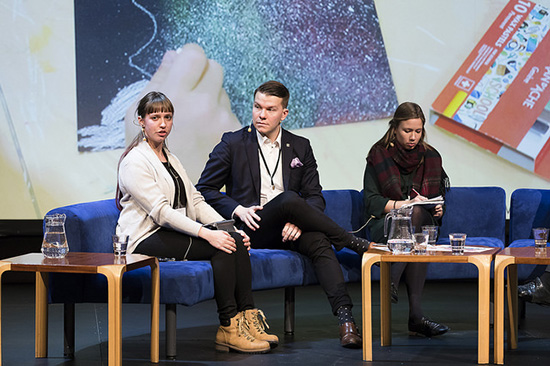The panels on the first day of the Rovaniemi Arctic Spirit Conference focused on three aspects of the implementation of the UN Sustainable Development Goals in the Arctic region – economy, science, and the next generations.
From defining the most sustainable path of the economic growth to contributions and needs of the science to youth's understanding of the sustainable future, discussions brought important answers to questions crucial for the Arctic and the globe.
“Nobody is able to achieve any of the sustainable development goals alone”, said Liisa Rohweder, General Secretary of WWF Finland, one of the panelists at the discussion during which the participants searched for answers to the question: “what kind of economic development is needed?”
Referring to the last of seventeen UN's Sustainable Development Goals which highlights of the importance of partnerships, the panelists stressed that the last goal is not only not the least but actually the most important. To achieve the sustainable development goals all of us need to work together: societies, governments, industry, civil society groups, indigenous peoples, and researchers. This is particularly important to the future of the economic growth and innovation.
As Stephen Mooney, Director of Cold Climate Innovation at the Yukon Research Centre, explained, business has to come from the society as the future of the economic development in the Arctic depends on the social entrepreneurship. Another important issue was brought up by Katri Kulmuni, Chair of UN Association of Finland, who highlighted that we have to connect research and businesses to ensure that science does not stay within the walls of laboratories, but is commercialized and brought to the people.
A challenge of commercialization is linked to the investment as the question arises: how to make the Arctic an attractive investment market? We need to present the region to investors as a peaceful and democratic region that is a safe and stable place to invest. On the other hand, small investments are crucial – grass-root enterprises can bring even better results as they understand the specifics of the region.
However, investment is not enough – a prospering economy can only be built by the society, which needs knowledge and competences to do so. Firstly, education for sustainability in the Arctic is crucial. In addition, we have to flip the paradigm where knowledge is brought to the community and simply left there. Communities should be more involved in innovation – from being included in the decision-making process to actually being the driving force of the innovative solutions.
Where in all this is the place of the scientific community? This question was debated during the second panel, “Contributions and needs of Arctic science”. Eeva Furman, member of the working group drafting the UN’s Global Sustainable Development Report, reminded that science and innovation are present in people's lives for thousands of years making their lives better. Already centuries ago, people realized that it is not simply about having knowledge but about implementing it.
It is crucial to ensure that science serves communities. It is the people from the communities that should benefit from the knowledge. In the context of the Arctic, we have to remember that even though Western science and traditional knowledge are different ways of knowing, they are equally valuable. Therefore engaging with indigenous societies is crucial for the scientific community to ensure that their challenges are addressed adequately.
The scientific community should also support the decision-making process and policy-makers in drafting the laws that reflect the current state of the research. For that, governments have to ensure that scientists have funds and access, but also that the researchers are heard – there is a need for a stronger willingness to listen not only to scientists who work for governmental organizations, but also scientists from all around the globe.
Lars-Otto Reiersen, Executive Secretary of the Arctic Monitoring and Assessment Programme, highlighted that communication is the key – one of the challenges is that the scientific language is unreadable for the communities and decision-makers. On the other hand, various scientific groups also do not communicate between each other. “We have to learn to communicate with each other and to communicate our knowledge to the society”, he explained.

Summarizing the discussion, the President of the University of the Arctic, Lars Kullerud, reminded that 2030 is not a far future. “Young people of today will be the leaders of 2030”.
Three of the future leaders took part in the last discussion that aimed to answer the question “What does sustainable development mean for the next Arctic generation?”
“If you want young people to stay in the Arctic, you have to provide them with the conditions that will make them want to stay,” said Lars-Otto Reiersen, who joined the future leaders' debate. Lacking connectivity, still a burning problem in Northern Canada and other parts of the Arctic region and insufficient number of sustainable travel opportunities were thoroughly discussed.
The favourite Sustainable Development Goals according to the panel participants are ensuring access to affordable, reliable, sustainable and modern energy for all, building resilient infrastructure, promoting sustainable industrialization and fostering innovation, as well as the goal of sustainable consumption and production patterns.
Sunna Kokkonen, Former Chair of Barents Regional Youth Council, highlighted that each of us make decisions about the future of the Arctic and the Earth every day. Whether you bicycle or take a car, whether you live in a big mansion or a small apartment, whether you buy new clothes every month or visit second-hand shops – all these small choices we make influence our common future. If you want to change the world, go and do it – Sunna concluded the discussions of the first day of the Conference.
Photos: Marko Junttila/Arctic Centre